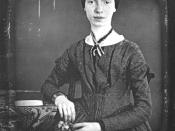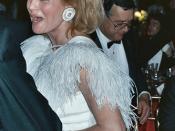From beyond the grave, the narrator of Emily Dickinson's "Because I Could not Stop for Death," also once published under the title "The Chariot", describes the peaceful process of her death which is personified as a gentleman who escorts her in his carriage. In this striking poem, Dickinson employs various poetic devices to reveal the narrator's calm acceptance of death. In fact, it seems to be presented as no more frightening than being taken on a date with a suitor. All other literary techniques, of which there are many, elaborate on this theme and further the tone of "civility" that brings the poem to its climatic moment when it really becomes clear to the speaker that her death is reality and even how the centuries that have passed since its occurrence have seemed like no time at all (8).
The first line indicates the theme by using the word "death".
In a critical analysis of the poem by Allen Tate, he says that "every image is precise and moreover not merely beautiful, but fused with the central idea" which in the poem is death (Tate, 84). Engle's main point on "Because I Could Not Stop for Death" is that Dickinson uses the poem to refute death in its entirety. She begins by citing the opening line of the poem. Engle interprets this line to mean that Death, as an end point, ceases to be: "It is simply not her nature to stop for Death. She realizes that she cannot recognize Death's power over her. Once she reckons with that eternal or divine bent within her, Death stops; that is, Death ceases to be what Death is- and end," (Engle 74). This brings in the other character in the poem that also takes the carriage ride with, almost posing as...


